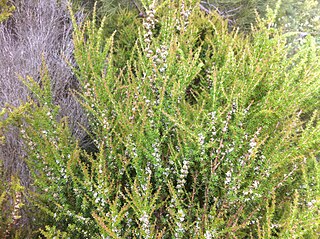
Lantana ( ) is a genus of about 150 species of perennial flowering plants in the verbena family, Verbenaceae. They are native to tropical regions of the Americas and Africa but exist as an introduced species in numerous areas, especially in the Australian-Pacific region, South and Northeastern part of India. The genus includes both herbaceous plants and shrubs growing to 0.5–2 m (1.6–6.6 ft) tall. Their common names are shrub verbenas or lantanas. The generic name originated in Late Latin, where it refers to the unrelated Viburnum lantana.

Agonis is a genus in the plant family Myrtaceae. All are endemic to Western Australia, growing near the coast in the south west.

Agonis flexuosa is a species of tree that grows in the south west of Western Australia. It is easily the most common of the Agonis species, and is one of the most recognisable trees of Western Australia, being commonly grown in parks and on road verges in Perth.

Kunzea is a genus of plants in the family Myrtaceae and is endemic to Australasia. They are shrubs, sometimes small trees and usually have small, crowded, rather aromatic leaves. The flowers are similar to those of plants in the genus Leptospermum but differ in having stamens that are longer than the petals. Most kunzeas are endemic to Western Australia but a few occur in eastern Australia and a few are found in New Zealand. The taxonomy of the genus is not settled and is complicated by the existence of a number of hybrids.

Beaufortia is a genus of woody shrubs and small trees in the family Myrtaceae and is endemic to the south-west of Western Australia. The genus Beaufortia is closely related to Melaleuca, Calothamnus, Regelia and several others, differing mainly in the way the anthers are attached to the stalks of the stamens, and in the way they open to release their pollen. Beaufortia anthers are attached at one end and open by splitting at the other.

Taxandria juniperina commonly known as wattie, native cedar, Warren River cedar or juniper myrtle is a species of tree that grows in the south west corner of Western Australia. This plant was previously classified as Agonis juniperina but is now part of the genus Taxandria. The Noongar peoples know the tree as watti.

Regelia is a genus of flowering plants in the family Myrtaceae and is endemic to the south-west of Western Australia. The genus is composed of five species of small leaved, evergreen shrubs which have heads of flowers on the ends of branches which continue to grow after flowering. Another species, previously known as Regelia punicea and which is endemic to Kakadu National Park in the Northern Territory, has been transferred to Melaleuca punicea.

Taxandria is a group of plants in the family Myrtaceae described as a genus in 2007. The entire genus is endemic to Western Australia, growing near the coast in the South West corner of the State.

Verticordia is a genus of more than 100 species of plants commonly known as featherflowers, in the myrtle family, Myrtaceae. They range in form from very small shrubs such as V. verticordina to trees like V. cunninghamii, some spindly, others dense and bushy, but the majority are woody shrubs up to 2.0 m (7 ft) tall. The flowers are variously described as "feathery", "woolly" or "hairy" and are found in most colours except blue. They often appear to be in rounded groups or spikes but in fact are always single, each flower borne on a separate stalk in a leaf axil. Each flower has five sepals and five petals all of a similar size with the sepals often having feathery or hairy lobes. There are usually ten stamens alternating with variously shaped staminodes. The style is simple, usually not extending beyond the petals and often has hairs near the tip. All but two species are found in Southwest Australia, the other two occurring in the Northern Territory.

Taxandria marginata is a species of shrub that grows in the south west corner of Western Australia. This plant was previously classified as Agonis marginata but was reclassified by Wheeler and Marchant into the new genus Taxandria in a 2007 revision.

Paragonis grandiflora is a plant species, endemic to the Southwest of Western Australia.
Agonis baxteri is a shrub that is native to Western Australia.

Taxandria parviceps, commonly known as tea tree, is a shrub species that grows on the south west coast of Western Australia. This plant was previously classified as Agonis parviceps but is now part of the Taxandria genus.

Taxandria spathulata is a shrub species that grows along the southern coast of Western Australia. This plant was previously classified as Agonis spathulata but is now part of the Taxandria genus.

Taxandria linearifolia, also known as the swamp peppermint or the coarse teatree, is a small tree or shrub species that grows along south west coastal areas of Western Australia. This plant was previously classified as Agonis linearifolia but is now part of the Taxandria genus.
Taxandria floribunda is a small tree or shrub species that is endemic to an area in southern Western Australia. This plant was previously classified as Agonis floribunda but is now part of the Taxandria genus.
Taxandria callistachys is a shrub species that is endemic to an area in southern Western Australia.
Taxandria fragrans is a shrub species that is endemic to an area in south western Western Australia.

Taxandria inundata is a species of shrub in the Myrtaceae family that is endemic to an area along the south western coast of Western Australia.
Rinzia carnosa, commonly known as the fleshy leaved rinzia, is a plant species of the family Myrtaceae endemic to Western Australia.













